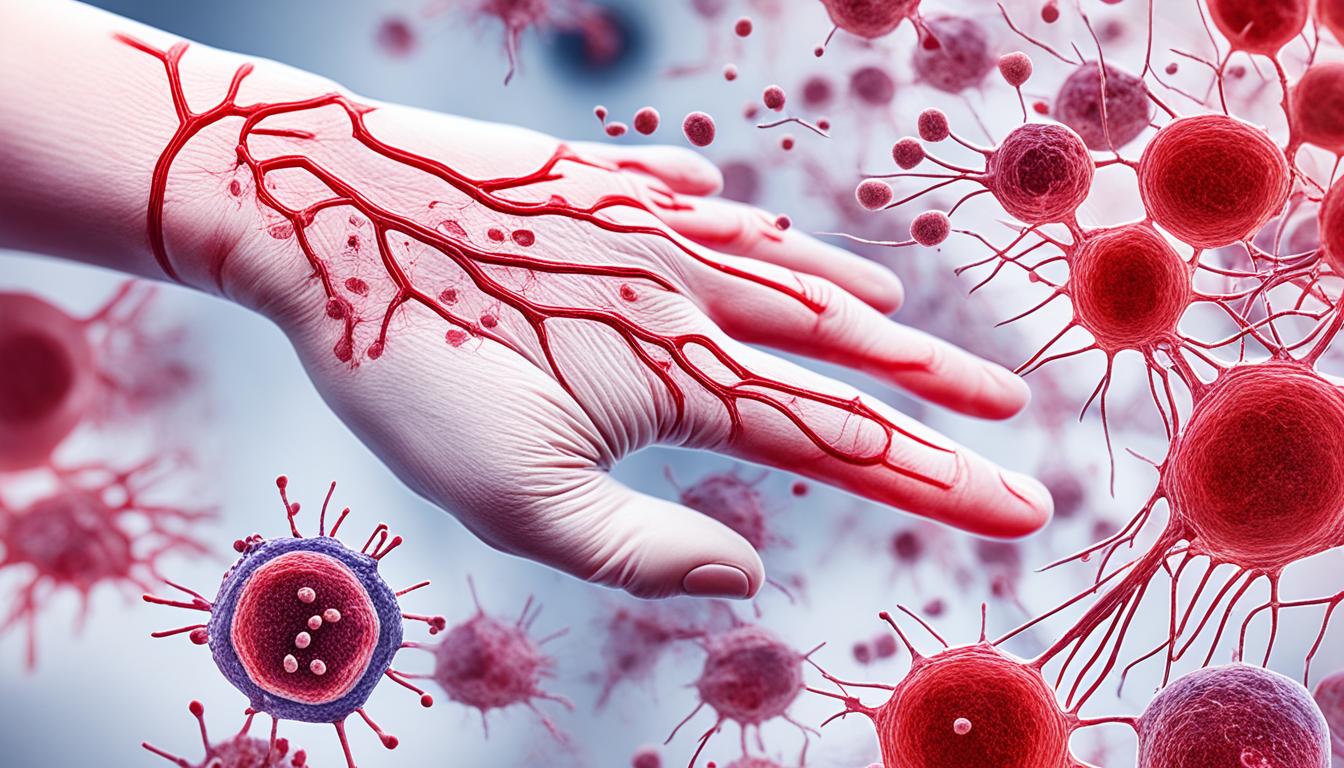Dermatitis scratch, also known as eczema, is a common skin problem. It causes itching, redness, and a rash. This can make living uncomfortable. It is part of a category of skin conditions called inflammatory skin disorders.
In children, eczema symptoms are common. The rates may vary by location. Some places have more kids with eczema symptoms [1]. Eczema in adults can be serious, often linking to asthma and other health issues [2]. The main type, atopic dermatitis, is the result of genes and the environment [3]. Things like pollen and diesel fumes can make it worse [4, 5].
Key Takeaways:
- Dermatitis scratch, also known as eczema, is an inflammatory skin disorder causing itching, redness, and a rash.
- Eczema symptoms are prevalent in both children and adults, with higher rates reported in certain regions.
- The pathogenesis of atopic dermatitis involves a combination of genetic and environmental factors.
- Allergens in the environment, such as pollen and diesel exhaust particles, can trigger eczema symptoms.
- Managing and treating dermatitis scratch requires a multidimensional approach.
Traditional Treatments for Dermatitis Scratch
Atopic dermatitis is usually treated with creams you put on your skin. These creams help with the itching and reduce the redness and swelling. The two main types are corticosteroids and moisturizers.
Corticosteroids: These are anti-inflammatory medicines. They lower itching and redness by quieting the immune system. You can get them in different strengths and forms. The type you use depends on how bad the rash is and where it is.
Moisturizers: Keeping your skin moist is key to managing atopic dermatitis. Moisturizers stop your skin from losing water. They also stop irritants from getting in. Look for ones that have no smell and don’t have things that cause allergies. Put them on right after you bathe to keep the moisture in.
Guidelines for Treatment of Atopic Eczema
Doctors recommend a mix of methods to treat atopic eczema. The focus is on finding and avoiding things that make the condition worse. This includes staying away from allergens and using gentle products.
- Work and home must be free from things that trigger your eczema.
- Be gentle with your skin by using mild soaps and not rubbing it too hard when you dry off after a bath.
- Use the right creams and ointments as directed by a doctor to calm the itch and redness.
Biological Treatments in Atopic Dermatitis
For some people, the usual treatments don’t work well. In these cases, doctors might try biologics. These are medicines that target the specific way your body overreacts, which leads to skin problems.
Monoclonal antibodies are one type of biologic. They change the immune system’s response to reduce swelling. They are given as shots or infusions by a doctor.
But, these advanced treatments are not for everyone. They require careful thinking about the risks and benefits with your healthcare team.
Stem Cell Therapy for Dermatitis Scratch
Stem cell therapy offers a new way to treat dermatitis scratch effectively. Mesenchymal stem cells, or MSCs, stand out. They can help with several health issues, significantly those that cause inflammation [9, 10]. For dermatitis scratch, MSCs shine by controlling the immune system and helping in healing [11, 12, 13, 14, 15].
Another stem cell type, Muse cells, is also becoming popular in dermatology. Muse cells are special because they can turn into various cell types to repair tissue. They are showing great hope in treating skin conditions. In atopic dermatitis, Muse cells can ease itching, lessen inflammation, and speed up healing
What makes stem cell therapy unique is its focus on the root causes of dermatitis scratch. Unlike common treatments that deal with symptoms, stem cell therapy works to adjust the immune response and heal the skin damage. This method really changes how we can address atopic dermatitis.
There’s still much to learn about how effective stem cells can really be for dermatitis scratch. But early signs are optimistic, showing that they could make a big difference for people with skin conditions.
Current Research and Future Directions
Today, scientists are looking at different sources of MSCs, from bone marrow to dental pulp, to see what works best. They are experimenting with how to deliver these cells effectively for the best outcomes. This includes looking into new tech that could lead to treatments made just for the patient.
There’s also a lot of work to understand how MSCs and Muse cells help in atopic dermatitis. Figuring this out could give us even better ways to treat the disease.
| Advantages of Stem Cell Therapy for Dermatitis Scratch | Challenges and Considerations |
|---|---|
| – Immunomodulatory effects | – Safety and long-term effects |
| – Tissue repair capabilities | – Standardization of MSC isolation and characterization protocols |
| – Potential for regenerative medicine | – Optimal dosage and administration route |
| – Non-invasive treatment option | – Patient selection criteria |
Even though there are hurdles, stem cell therapy could change how we handle dermatitis scratch for the better. With more study, it could become a key player in the field of dermatology. This could mean better treatments for those dealing with atopic dermatitis and similar skin issues.
Conclusion
Stem cell therapy is showing exciting results for skin disorders like atopic dermatitis. Scientists are using mesenchymal and Muse cells. These cells help the immune system and heal the skin. More studies are needed to confirm if this therapy is really safe and works well.
This kind of therapy might be a fresh start for patients with atopic dermatitis. It uses the healing power of stem cells. This approach could lessen symptoms and tackle the cause of atopic dermatitis.
Current treatments, such as ointments and pills, are useful. But, stem cell therapy brings hope for a lasting solution. It might open new doors to fight against skin inflammation. This could make life better for many people.

